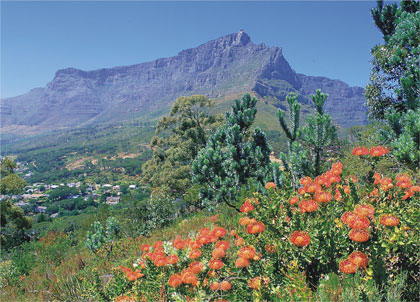South Africa is located on the southern tip of Africa and is
bordered by the Atlantic Ocean on the west and the Indian Ocean on the south
and east. Its neighbouring countries are Namibia, Botswana, Zimbabwe, Mozambique,
and Swaziland. The Kingdom of Lesotho is situated in the eastern central plain
of the country.
South Africa's total land area is 1 219 912 sq. km (471,011 sq.
mi). The country is five times larger than Great Britain and three times the
size of Texas.
South Africa is divided into 9 provinces: Western Cape,
Eastern Cape, Northern Cape, Free State, Gauteng, KwaZulu-Natal, Limpopo, North
West, and Mpumalanga.
South Africa boasts three capital cities. These are:
Bloemfontein: The location of the Supreme Court of Appeal,
the highest court in non-constitutional matters.
The Constitutional Court in
Johannesburg is the highest court in constitutional matters.
Cape Town: The legislative capital of South Africa and home
to the seat of Parliament.
Pretoria: The administrative capital of South Africa.
South Africa is a diverse country filled with a myriad of
traditional origins, languages and beliefs, and is home to over 47 million
people from all walks of life. The population of South Africa is divided into
four ethnic groups, black Africans, whites, coloureds, and Asians.
Officially, the Republic of South Africa, this country is a
constitutional democracy with a government and independent judiciary, all
operating under a parliamentary system. The national, provincial, and local
levels of government all have legislative and executive authority in their own
regions. Advisory bodies operate at both national and provincial levels and are
drawn from traditional leaders of South Africa.
South Africa is 2 hours ahead of Greenwich Mean Time (GTM),
one hour ahead of Central European Wintertime, 8 hours behind Australian
Eastern Standard Time and 7 hours ahead of Eastern Standard Wintertime. There
is no daylight saving and no time zone changes between South Africa and its
neighbouring countries, or between the 9 provinces of South Africa.
South Africa is a year round holiday destination, but it all
depends on what kind of experience you are looking for. Different activities
are better suited to different seasons.
For the best game watching, visit during a South African
spring (August – October), Whale watching from mid-June to the end of October and
for diving and surfing, April to September. The beaches of Cape Town, Port
Elizabeth and Durban are great and best visited in the peak of summer (November
– February), but are often overcrowded.
The unit of currency is the South African Rand, denoted by
the symbol R. One hundred cents makes up one Rand (R1). Coins are available in
denominations of 5c, 10c, 20c, 50c, R1, R2 and R5, and notes in denominations
of R10, R20, R50, R100 and R200.
The Rand is weaker than the Pound and Dollar, making a visit
to South Africa highly affordable by international standards. Accommodation,
eating out and shopping in South Africa offers great value for money to the
international traveler.
Your foreign currency can be exchanged at most local banks
and Bureaux de Change. There are many banks and ATM’s all around South Africa,
including airports, petrol stations and malls.
South Africa is generally a very casual country, with warm,
windy days and chilly nights. Denims, t-shirts, and skirts are fine for during
the day. In summer, the days range from pleasant, to very hot and evenings are
balmy. In some areas of South Africa, winter is wet and windy during the day,
while in other areas it is dry, hot, and humid.
Winter nights are, however, always cold. Formal to
semi-formal attire is worn to work, upper-class restaurants, and clubs. Casual
wear is accepted at most restaurants, pubs, and bars. The majority of clubs do
not accept guests in running shoes. Bathing suits – full or two pieces - are
for the beach.




No comments:
Post a Comment